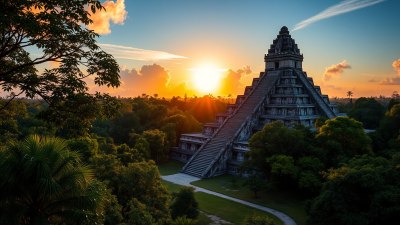The Tikal Temples in Guatemala Climb Back Into the Sky Every Morning
Explore the majestic Tikal Temples in Guatemala, their history, and the daily sunrise transformation.

Tikal, located in the heart of the Guatemalan rainforest, stands as one of the most prominent archaeological sites of the ancient Maya civilization. Emerging from the dense jungle, the Tikal Temples rise majestically towards the sky, creating a breathtaking silhouette against the backdrop of dawn. Every morning, as the sun rises above the canopy, these ancient structures appear to climb back into the sky, reviving the stories of a civilization that once thrived in this vibrant landscape.
The story of Tikal begins over a thousand years before the arrival of European explorers, dating back to around 1000 B.C. The city flourished during the Classic Period of Maya civilization, around 200 to 900 A.D., when it became one of the most powerful city-states in the region. At its peak, Tikal was home to tens of thousands of people, with sprawling urban areas, grand temples, and ceremonial centers.
At the heart of this magnificent city are its temples, each with its own unique design and history. The Temple I, also known as Temple of the Great Jaguar, is perhaps the most iconic structure. Standing at 47 meters (154 feet), this temple served as a funerary monument for the ruler Jasaw Chan K'awil I. The temple's design reflects the architectural ingenuity of the Maya, featuring a steep stairway that leads to a shrine at the top. As the sun rises, the temple is beautifully illuminated, revealing intricate carvings that depict the ruler's accomplishments and divine connections.
The Temple II, or Temple of the Masks, is another impressive structure located adjacent to Temple I. Slightly smaller in size, Temple II features a distinctive pyramid shape and is adorned with masks that represent the Maya's spiritual beliefs. The moment the golden rays of the morning sun hit this temple, its stone façade comes to life, showcasing the skillful artistry of the ancient builders. Together, these two temples create a stunning visual display that captures the mystique of Tikal.
To truly appreciate the grandeur of Tikal, visitors often rise before dawn to witness the sunrise over the temple complex. As the sun ascends, the jungle awakens, filling the air with the sounds of howler monkeys and tropical birds. This moment of tranquility is a testament to the harmony between nature and the ancient structures that once stood as the focal point of Maya life.
The landscapes surrounding Tikal add to its allure. The site is enveloped by lush vegetation and towering trees, offering a glimpse into the biodiversity of the region. Many species of flora and fauna are native to this area, and the chirping of parrots and rustling of leaves create an immersive experience for those who wander through the ruins. Walking through the jungle paths, visitors may encounter various wildlife, including coatis, toucans, and spider monkeys, enhancing the magical atmosphere of the site.
Tikal's significance is not only rooted in its architecture but also in its astronomical alignments. The Maya were keen astronomers, and Tikal served as a vital observatory for tracking celestial movements. Many of the temples and pyramids are aligned with specific astronomical events, such as solstices and equinoxes. As the sun rises on these significant dates, the shadows cast by the structures create mesmerizing patterns, reflecting the Maya's deep understanding of the cosmos.
Understanding Maya Culture Through Tikal
Exploring Tikal goes beyond mere sightseeing; it provides invaluable insights into Maya culture, religion, and social structure. The site serves as a window into a highly developed society that had complex belief systems, trade networks, and governance structures. Each temple and plaza tells a story of religious ceremonies, political power, and cultural practices that shaped the Maya world.
The Maya viewed their environment as sacred, and Tikal was no exception. Temples served not only as sanctuaries for worship but also as sites for rituals and celebrations. The ruins include stelae, which are carved stone monuments that commemorate important events and individuals in Maya history. These stelae often depict rulers and their achievements, providing an understanding of the political landscape of the time.
Aside from its spiritual and political significance, Tikal was also a center for trade and communication. Artifacts found at the site reveal connections with other Maya cities and distant cultures. The presence of jade, obsidian, and other valuable materials indicates the thriving commerce that took place in Tikal, making it a key player in the region's economy. Visitors can marvel at these artifacts in the nearby museums, which showcase the craftsmanship of the ancient Maya and the artistry embedded in their daily lives.
The Symbolism of the Temples
The temples at Tikal are not merely architectural achievements; they embody deep cultural symbolism. The pyramid shape reflects the Maya worldview, where the heavens, earth, and underworld are interconnected. As these structures ascend towards the sky, they symbolize the aspiration to connect with the divine. The temples are often interpreted as representations of the sacred mountain, which played a crucial role in Maya cosmology.
Moreover, the decoration of the temples carries profound meanings. Many carvings and reliefs illustrate myths, deities, and significant historical events. The imagery often conveys messages about power, divinity, and the cyclical nature of life and death. Gathering around these temples during sunrise serves as a moment for reflection, allowing visitors to engage with the profound legacy of the Maya.
Preserving Tikal for Future Generations
Today, Tikal is not only a UNESCO World Heritage Site but also a symbol of cultural resilience. Preservation efforts are crucial to protect the ruins from the effects of time, tourism, and environmental challenges. The Guatemalan government, along with various international organizations, has implemented initiatives to safeguard the site's integrity while promoting sustainable tourism practices. The commitment to conservation ensures that future generations can experience the magic of Tikal and appreciate its significance in global history.
Community involvement plays a vital role in preservation efforts. Local Maya communities actively participate in protecting their ancestral heritage. They not only help maintain the site but also share their traditions and knowledge with visitors, enriching the overall experience. The connection between the modern Maya and their ancestors is palpable, creating a bridge between past and present.
Visiting Tikal: A Journey Back in Time
For travelers seeking a unique adventure, a visit to Tikal offers an opportunity to step back in time. The site is accessible by various means, including guided tours, shuttles, and self-guided exploration. Many choose to stay in nearby accommodations, allowing for early morning excursions to catch the sunrise over the temples.
Once at Tikal, visitors can wander through ancient plazas, climb to the temple tops, and explore the remnants of once-vibrant neighborhoods. The highlight, of course, remains the glorious sunrise spectacle that transforms the architecture into a luminous portrayal of history. Each moment spent amongst the ruins reminds us of the ingenuity and artistry of the Maya, urging us to reflect on our own existence in the vast timeline of humanity.
In essence, the Tikal Temples are more than mere stone structures; they represent an enduring connection to the past, a cultural narrative that continues to resonate through the ages. As the sun rises each morning, illuminating the stones and awakening the jungle, the spirit of Tikal climbs back into the sky, inviting us to partake in its timeless story.











